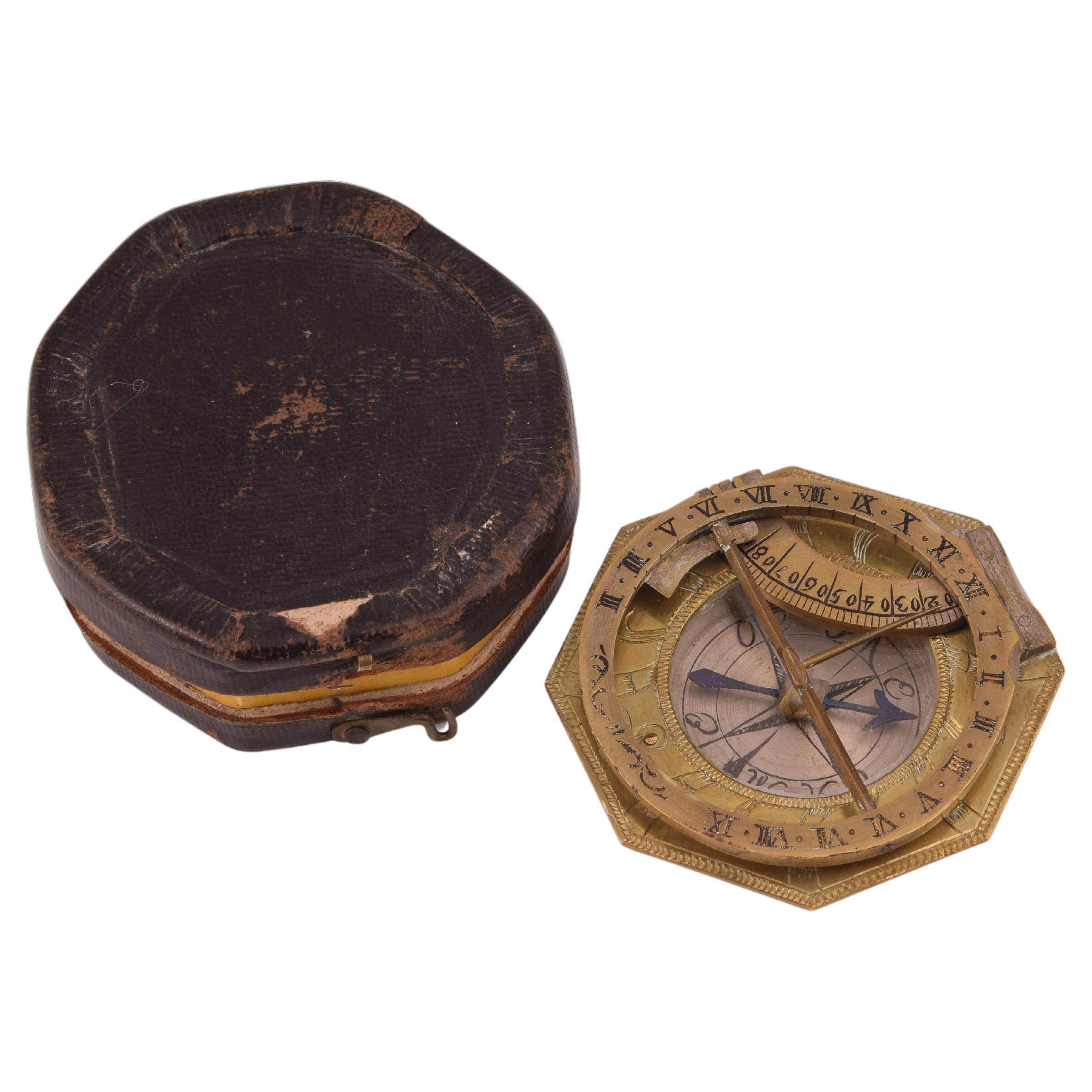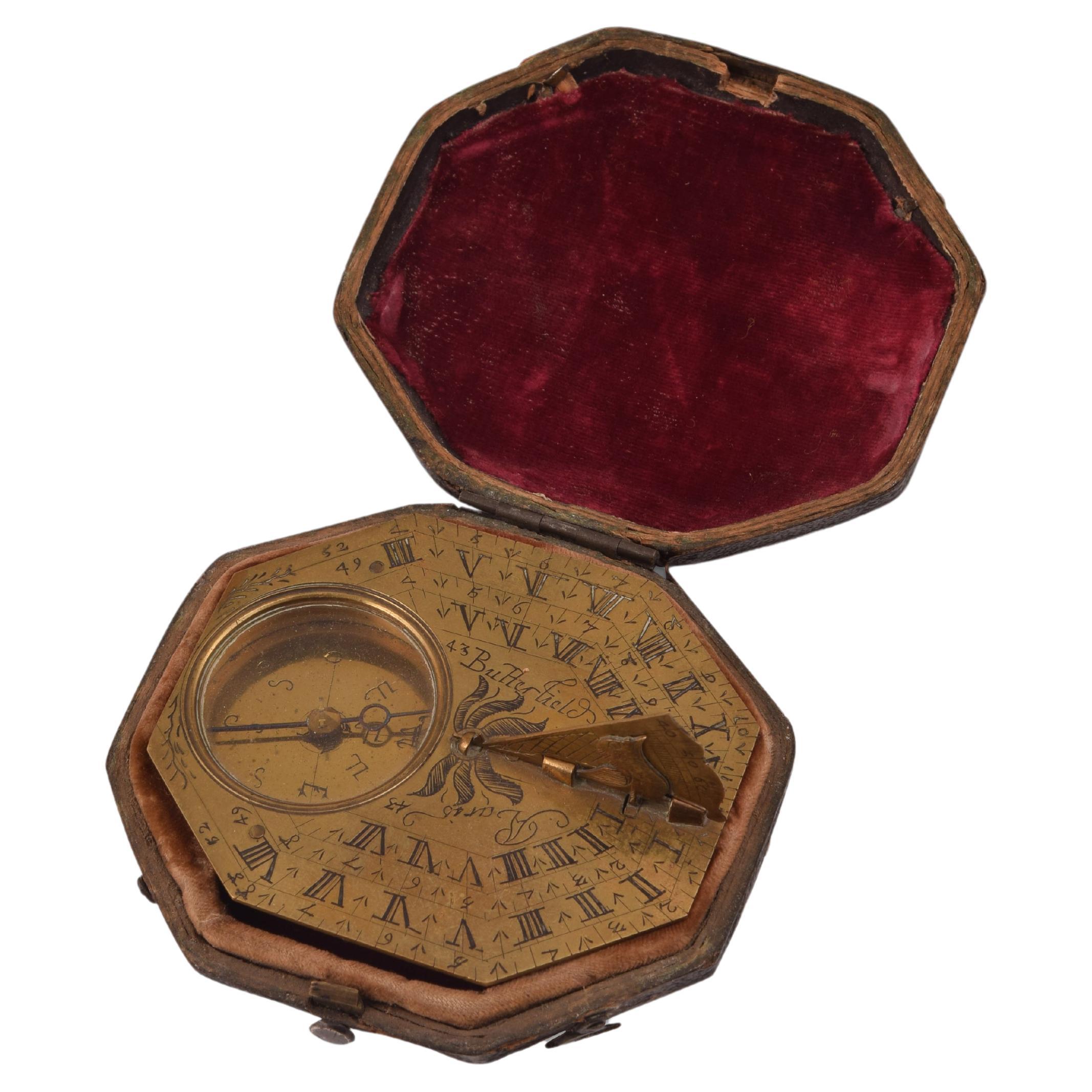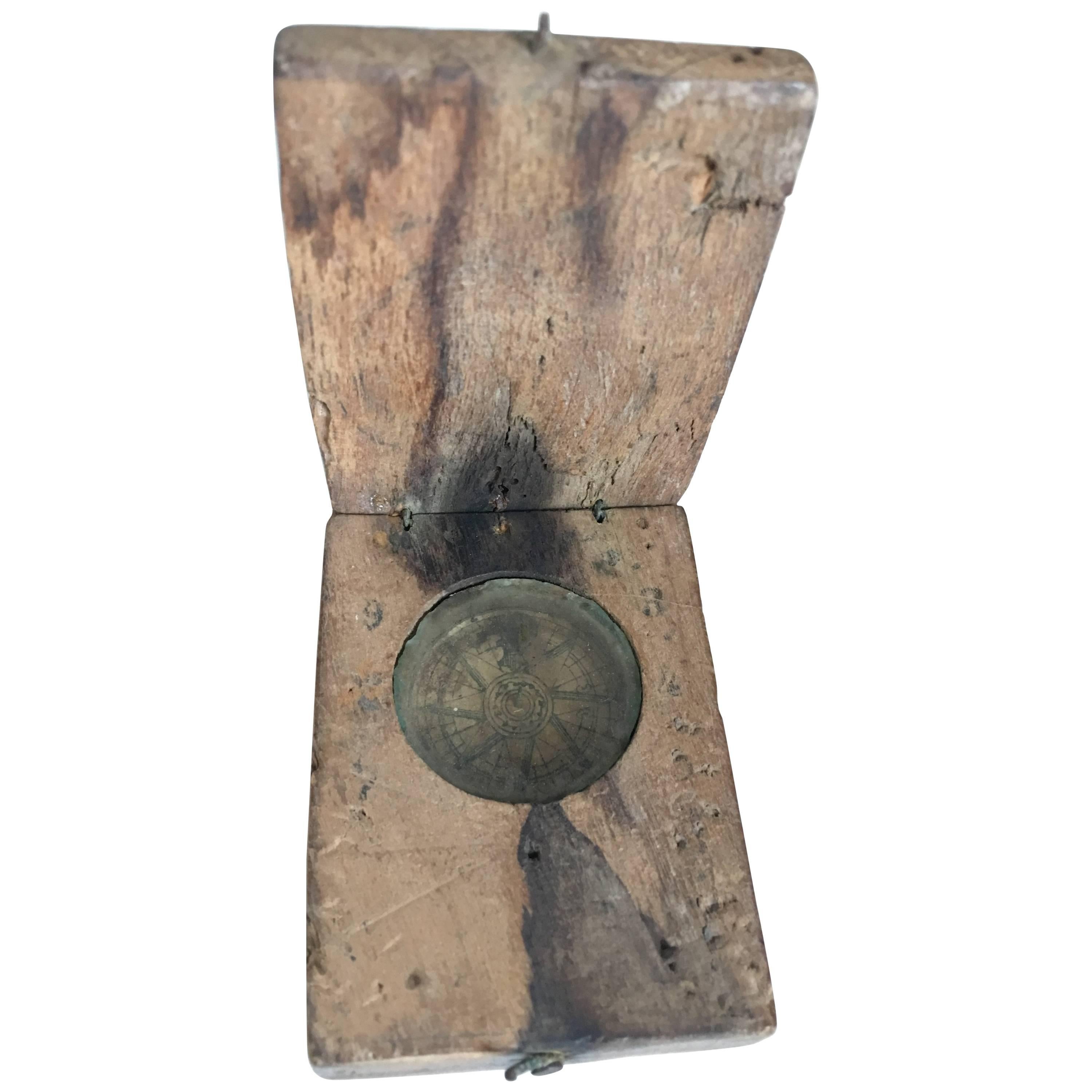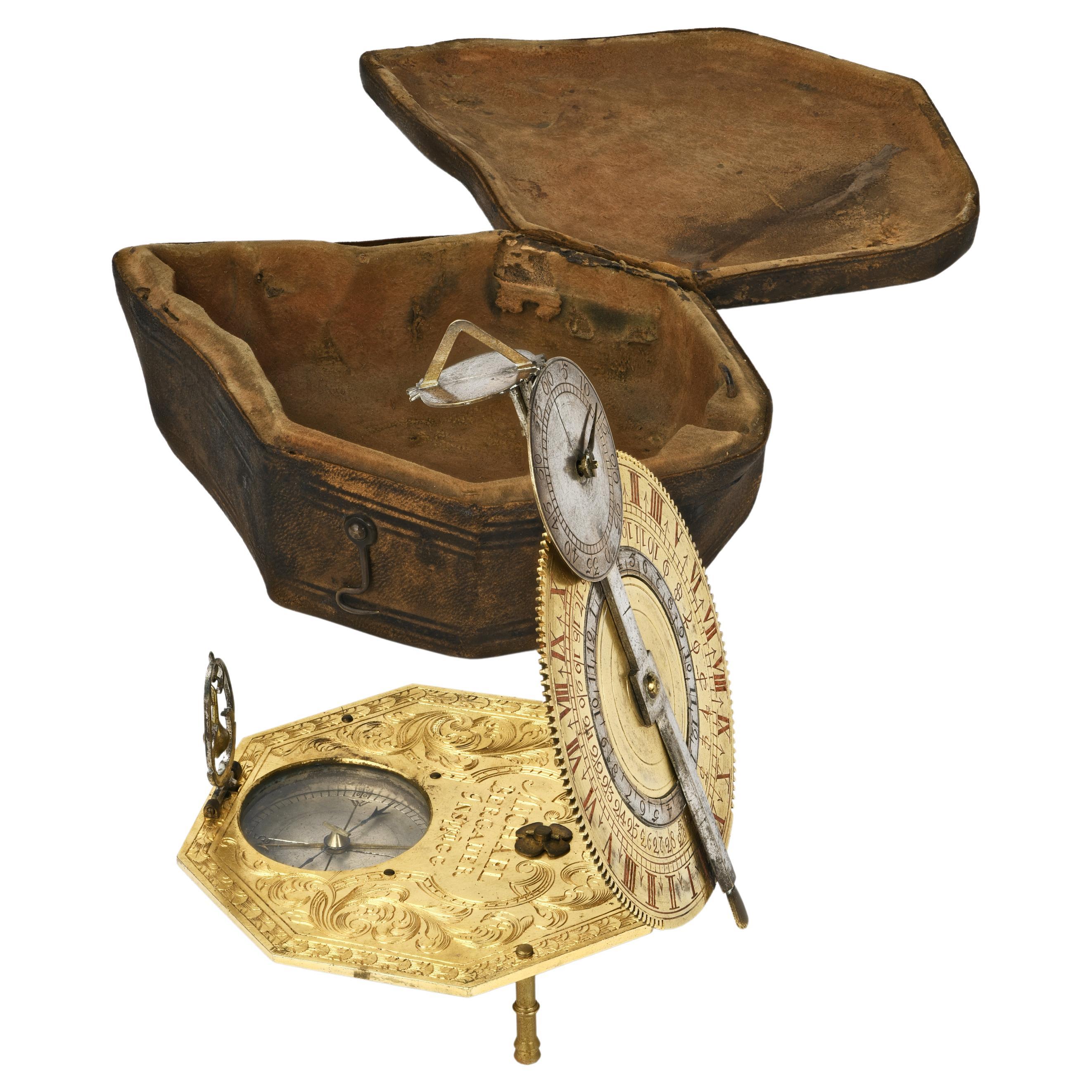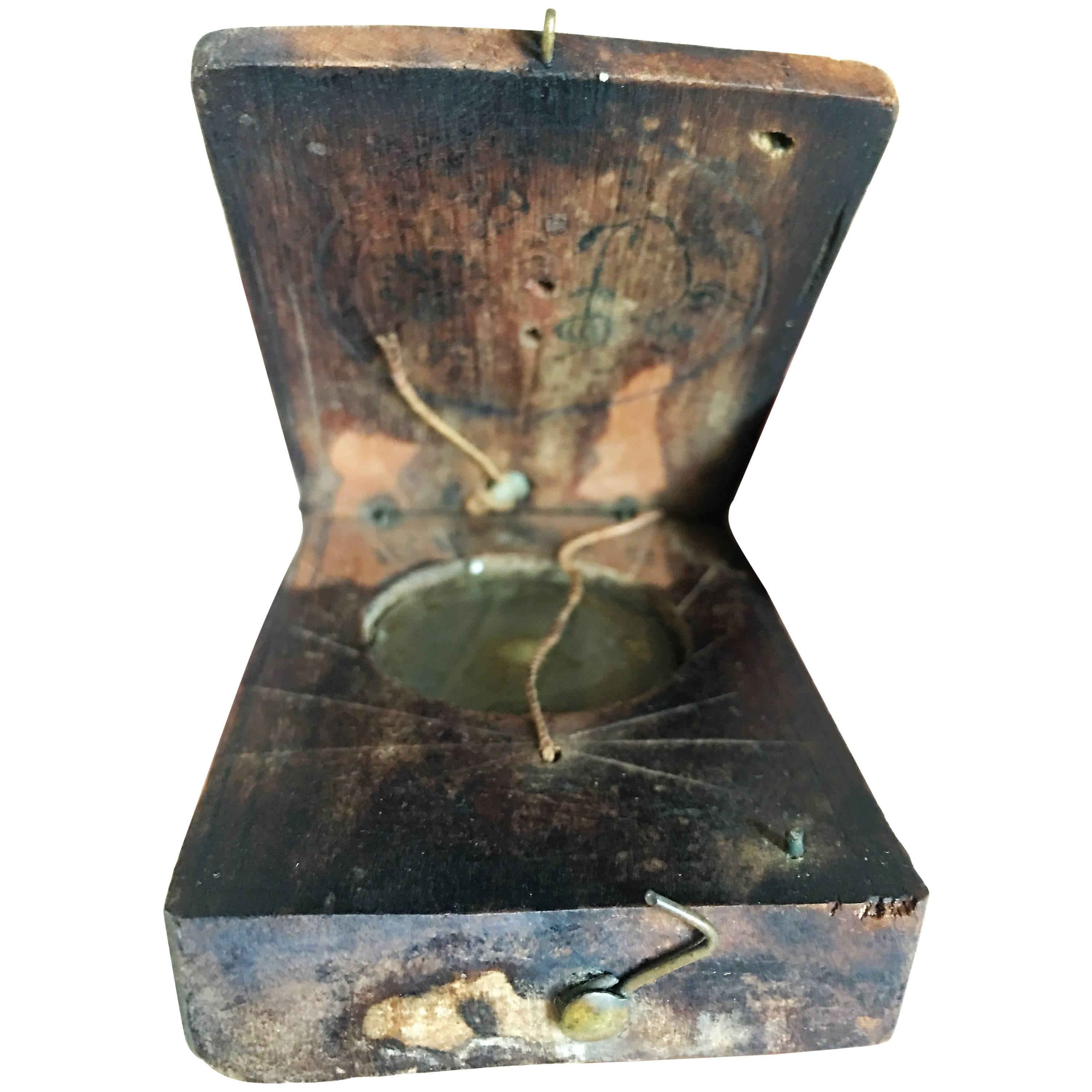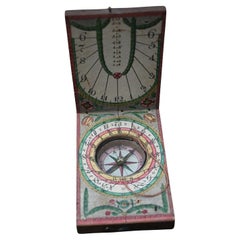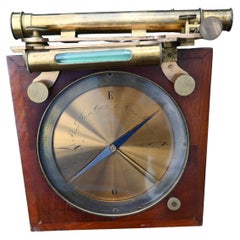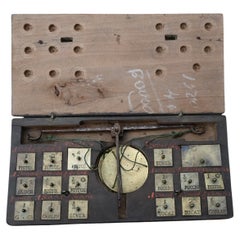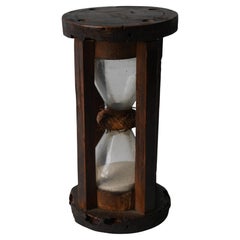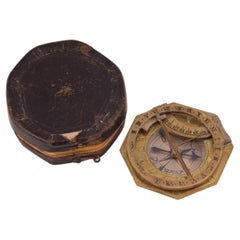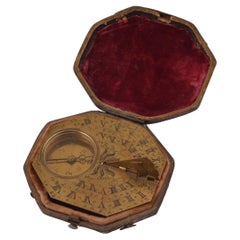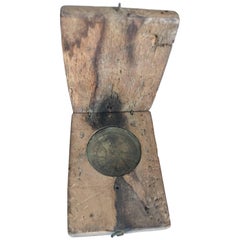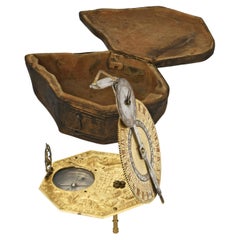Items Similar to Rare 18th Century Equatorial Sundial And Compass By Johann Nepomuk Schrettegger
Video Loading
Want more images or videos?
Request additional images or videos from the seller
1 of 14
Rare 18th Century Equatorial Sundial And Compass By Johann Nepomuk Schrettegger
$1,118.10
£846.99
€960
CA$1,548.98
A$1,737.29
CHF 909.79
MX$21,109.73
NOK 11,552.81
SEK 10,952.88
DKK 7,309.22
About the Item
"Rare 18th Century Equatorial Sundial And Compass By Johann Nepomuk Schrettegger,"
Rare 18th-Century Equinoctial Sundial & Compass by Johann Nepomuk Schrettegger, Augsburg
Maker: Johann Nepomuk Schrettegger
Origin: Augsburg, Germany
Date: Circa 1780–1800
Material: Gilt brass with engraved details
Provenance: Complete with original fitted case and instruction leaflet in German
Description:
Offered is a superb and rare example of an 18th-century equinoctial portable sundial and compass crafted by renowned scientific instrument maker Johann Nepomuk Schrettegger. Elegantly designed and meticulously engraved, this instrument features a rotating hour ring, an adjustable latitude arc (suitable for multiple geographic zones), and a fully functional magnetic compass with engraved cardinal directions.
The instrument is signed on the underside:
"Johann Schretttegger in Augsburg"—a hallmark of quality from one of the last great masters of Augsburg’s scientific instrument-making tradition.
Accompanied by its original octagonal case, lined with velvet and paper, and a rare printed German instruction leaflet, titled “Gebrauch dieses Compasses”, this set stands out as both a highly decorative and historically significant object. The condition of both the instrument and documentation suggests careful preservation and likely limited use.
Highlights:
Original folding equinoctial sundial and compass with ornate floral engraving
Signed by Schrettegger, a documented maker listed in major museum collections
Fully functional gnomon, hour ring, and compass
Rare survival of original instruction sheet and fitted case
Excellent patina and overall condition for its age
Dimensions: 6 x 6 cm
Comparable examples of Schrettegger’s work are held by institutions such as the Science Museum (London), Museum of the History of Science (Oxford), and the National Museum of Denmark.
This is an exceptional opportunity to acquire a museum-quality scientific instrument by a notable maker—perfect for collectors of scientific antiques, horological curiosities, or Enlightenment-era tools of travel and navigation.
- Dimensions:Height: 0.79 in (2 cm)Width: 2.37 in (6 cm)Depth: 2.37 in (6 cm)
- Style:Louis XVI (Of the Period)
- Materials and Techniques:
- Place of Origin:
- Period:
- Date of Manufacture:18th century
- Condition:Wear consistent with age and use. normal age traces.
- Seller Location:Bilzen, BE
- Reference Number:1stDibs: LU10361245692422
About the Seller
New to 1stDibs
Joined in the past six months.
5.0
Gold Seller
Premium sellers maintaining a 4.3+ rating and 24-hour response times
Established in 1987
1stDibs seller since 2025
8 sales on 1stDibs
Typical response time: <1 hour
- ShippingRetrieving quote...Shipping from: Bilzen, Belgium
- Return Policy
Authenticity Guarantee
In the unlikely event there’s an issue with an item’s authenticity, contact us within 1 year for a full refund. DetailsMoney-Back Guarantee
If your item is not as described, is damaged in transit, or does not arrive, contact us within 7 days for a full refund. Details24-Hour Cancellation
You have a 24-hour grace period in which to reconsider your purchase, with no questions asked.Vetted Professional Sellers
Our world-class sellers must adhere to strict standards for service and quality, maintaining the integrity of our listings.Price-Match Guarantee
If you find that a seller listed the same item for a lower price elsewhere, we’ll match it.Trusted Global Delivery
Our best-in-class carrier network provides specialized shipping options worldwide, including custom delivery.More From This Seller
View AllAntique 18th Century Diptych Portable Sundial And Compass by Beringer
By David Beringer
Located in Bilzen, BE
Antique 18th Century Diptych Sundial and Compass a portable wooden sundial with compass, of German origin, by David Beringer, Nuremberg, dating back to the 1780 circa, in good age re...
Category
Antique Late 18th Century German Louis XVI Scientific Instruments
Materials
Metal
Antique Surveyor's Circumcompendium Signed Brand Frères, 1850-1880
Located in Bilzen, BE
"Antique Surveyor's Circumcompendium Signed Brand Frères, 1850-1880"
Description: Antique Surveying Circumferentor by Brand Frères
Brand Frères, Optic...
Category
Antique Mid-19th Century Belgian Other Scientific Instruments
Materials
Brass
Antique 18th Century Trebuchet, Money Changer's Balance, With Its Weights
Located in Bilzen, BE
Wooden trebuchet with its weights.
These kind of scales were used by money changers to weigh golden coins in those days to avoid fraud
18th Century
The box measures 18 cm X 8.7 cm ...
Category
Antique 18th Century German Industrial Scientific Instruments
Materials
Brass, Wrought Iron
18th Century Maritime Hourglass 30 Seconds tilmer
Located in Bilzen, BE
"18th Century Maritime Hourglass 30 Second Stopwatch"
18th-Century Maritime Sandglass 30-Second Log Timer
Hand-Blown Glass, Original Wood Frame, Nautical Navigation Instrument
Heig...
Category
Antique 18th Century French Other Nautical Objects
Materials
Glass, Wood
Stamp Seal With Noble Blazon Coat Of Arms, 18th century
Located in Bilzen, BE
An important noble 18th century wax seal in wrought iron and brass, old patina, height 4 cm, surface of the stamp 3.2 x 3.4 cm
Category
Antique 18th Century French Louis XV Historical Memorabilia
Materials
Brass, Iron
Dutch Missal With Silver Mount, 1843
Located in Bilzen, BE
Dutch missal with solid silver mount, 1843 Gulpen, printed in Dutch
9.8 x 15.2 cm, thickness 4.2 cm
Category
Antique 1840s Dutch Baroque Religious Items
Materials
Silver
You May Also Like
Sundial and Compass with Case, Schrettegger, Johan, Augsburg, Germany, Ca 1800
Located in Madrid, ES
Sundial and compass with case. Bronze. SCHRETTEGGER, Johan. Augsburg, Germany, around 1800.
Sundial with a polygonal shape made of bronze, engraved with plant elements on the front,...
Category
Antique Late 18th Century German Neoclassical Scientific Instruments
Materials
Bronze, Other
Compass with Pocket Sundial, with Case, Bronze, Butterfield, Michael '1635-1724'
Located in Madrid, ES
Compass with pocket sundial, with case. Bronze. BUTTERFIELD, Michael (1635-1724). Paris, circa 1700.
Pocket sundial made of engraved metal, with a gno...
Category
Antique Early 18th Century French Neoclassical Scientific Instruments
Materials
Metal, Bronze, Other
19th Century, Compass and Sundial Together
Located in Miami, FL
19th century, compass and sundial together.
Category
Antique Late 19th Century French Baroque Scientific Instruments
Materials
Wood
Mechanical Equatorial Sundial, Johann Michael Bergauer, Ante 1745
By Johann Michael Bergauer
Located in Milano, IT
Johann Michael Bergauer (Simonsfeld, 1676 - Innsbruck, 1745 circa)
Mechanical equatorial sundial
Signed: Michael Bergauer Insprugg? Innsbruck?
Ante 1745
Gilded and silvered brass; glass.
Measures: closed 1.29 x 3.50 x 4.92 in (33 x 89 x 125 mm); open 5.19 x 3.50 x 3.81 in (132 x 89 x 97 mm).
Weight: the sundial 0.49 lb (224 g); the case 0, 20 lb (95 g)
Original wooden case covered in brown leather.
State of conservation: very good. It has some signs of use. The spring that allowed for the two parts of the instrument to remain open is missing (absent even in the comparative specimens kept in museums).
The sundial is composed of two overlapping plates hinged together on the north edge.
The base plate is octagonal and is supported by three turned legs. The upper face is gilded and a compass with a magnetic variation index has been inserted. The rest of the surface is occupied by a rich decoration of engraved scrolls, centered around the inscription “Michael Bergauer Insprugg”. A foldable oval support with a plumb-bob is attached with a hinge on the southern edge. On the reverse of the base plate a table of the latitudes of some European cities (expanded with the vertical writing “Meiland 40” on the edge and “Rome” deleted) and of Jerusalem has been engraved. A Cam marked for 0 °-70 ° is applied near the northern edge. This can be adjusted to change the inclination of the upper plate according to the latitude; originally a spring, now lost, made it possible to keep the two plates of the clock open.
The second plate is round, has a toothed edge and measures 3.26 in (83 mm) in diameter: it is slightly smaller than the octagonal base which it rests upon and overlaps when the instrument is closed.
The recto is gilded and there are three concentric graduated circles engraved on it:
- the outermost is the equatorial hour dial, numbered I-XII, I-XII;
- the second-one is that of days 1-30 of the lunar month and has “Aetas lunae” engraved on it;
- the third, silvered, is a subsidiary hour dial, with double numbering 1-12; originally it could have been rotated.
The engravings of the first two circles are enameled in red.
In the center - on the polar axis - there is an alidade, at the end of which is associated the silvered minute dial. This, in turn, is welded, perpendicularly, to a small disc, also silvered, with a triangular gnomon. The plate, alidade and minute dial are connected to each other by toothed mechanisms.
Below is the procedure for measuring the time:
1) Adjust the Cam under the base of the clock, based on the latitude of your location;
2) Place the watch on a flat surface using the plumb-bob and with the side closest to the compass facing south;
3) Keeping the instrument still, manually rotate the alidade until the shadow cast by the triangular gnomon on the small silvered disc falls on the line marked below it;
4) The hour and minutes can therefore be read on the hour and minute dials set on the alidade respectively.
Johann Michael Bergauer, who sometimes only signs his works as Michael Bergauer, was born in Simonsfeld, north of Vienna. His apprenticeship as a watchmaker took place in Landshut and he probably worked as a laborer in Augsburg before becoming a watchmaker at the court of Karl Philipp von der Pfalz in Innsbruck in 1708. In the following years, his repeated attempts to obtain Innsbruck citizenship are documented and, in 1721, he is listed as a resident. In 1724 he was admitted to the guild of watchmakers, with which however he had continuous problems. In 1732 he presented a "masterpiece". This is the last reference to his business; he must have died before or in 1745 because in that year his widow appealed to the City Council.
The mechanical sundial...
Category
Antique 1730s Austrian Baroque Scientific Instruments
Materials
Brass
Sundial with Compass and Case, Bronze, Bion, Nicholas, Paris, 18th Century
By Nicholas Bion
Located in Madrid, ES
Sundial with compass and case. Bronze. BION, Nicholas. Paris, 18th century.
Polygonal sundial with a bird-shaped gnomon and engraved triangular piece, which presents, on one side, ...
Category
Antique 18th Century French Neoclassical Scientific Instruments
Materials
Bronze, Other
19th Century Compass and Sundial Together
Located in Miami, FL
19th century compass and sundial together.
Category
Antique Late 19th Century French Baroque Scientific Instruments
Materials
Wood
More Ways To Browse
Antique German 18th Century
Antique Floral Engraving
18th Century Velvet
Antique Brass Hallmarks
Antique Engraving Tools
Antique Brass Sheets
Cardinal Ring
Danish Prints 18th Century
Antique Cardinal Ring
Antique Compass Sundial
German Sundial
Antique Brass Sundials
Antique Magnetic Compass
Portable Sundial
Antique Brass Sundial Compass
Black Forest Thermometer
English Binoculars
French Brass Compass
